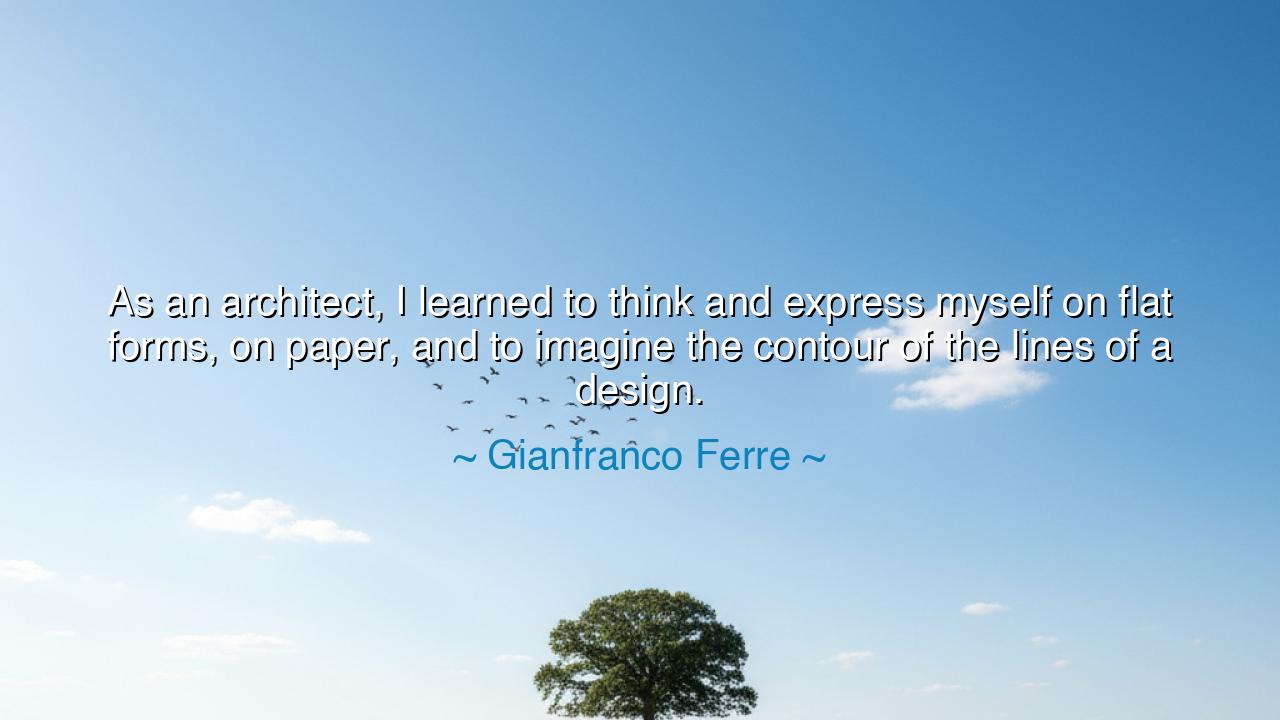
As an architect, I learned to think and express myself on flat
As an architect, I learned to think and express myself on flat forms, on paper, and to imagine the contour of the lines of a design.






In the still geometry of creation, where mind and matter converge, Gianfranco Ferré — architect turned designer — uttered words that reveal the sacred bridge between imagination and form: “As an architect, I learned to think and express myself on flat forms, on paper, and to imagine the contour of the lines of a design.” Within these words lies a profound meditation on vision, discipline, and the translation of spirit into structure. Ferré speaks not merely of architecture or fashion, but of the eternal process by which all creators give shape to the unseen. He reminds us that every masterpiece begins first as a whisper — a fragile sketch drawn upon the flat forms of the mind before it becomes flesh, fabric, or stone.
To “express oneself on paper” is an act of both humility and power. It is to confine the vastness of imagination to a surface — to translate infinite vision into measured line. In this, Ferré shows that creation demands both dream and discipline, both fire and form. The contour of the lines he imagines are not just marks on a page, but the outline of thought itself — the visible trace of an invisible idea. He teaches that before one can command the physical world, one must first master the inner geometry of thought. The architect’s page is the battlefield where chaos becomes harmony, where instinct bows to intellect, and where art first takes breath.
From this truth arises a lesson echoed throughout history. Consider the tale of Leonardo da Vinci, who, long before his machines could fly, filled endless pages with sketches — winged contraptions, human anatomy, celestial diagrams. To the untrained eye, these were mere drawings. But Leonardo, like Ferré, understood that the flat form was a divine intermediary — the sacred stage upon which spirit first touches matter. Every stroke of his pen was a prophecy; every line a preparation for the day when vision would rise into the third dimension. So too does Ferré remind us that every grand creation — whether a cathedral, a gown, or a civilization — begins first as a humble line on paper.
And yet, beyond this discipline lies imagination — the power to see beyond the flatness, to envision what the eye cannot yet behold. When Ferré speaks of imagining the contour of the lines of a design, he speaks of breathing life into stillness. He looks upon the paper not as a limit, but as a portal to infinity. In this act, he embodies the dual nature of all creation: the restraint of the architect and the freedom of the artist. It is not enough to draw; one must dream between the lines, to see what is not yet there, and to summon it into being.
This union of logic and imagination defines all great makers. The pyramids of Egypt, the domes of Florence, the garments of haute couture — all are born from the same sacred balance between structure and soul. The ancients understood this balance well. The builders of temples knew that every column must obey the laws of weight, yet reach upward toward the divine. Ferré’s philosophy is their echo in a modern form — a reminder that true beauty lives at the intersection of intellect and inspiration.
Let the young creators who hear this take heed: do not despise the flat form. Do not rush to the grandeur of finished work without first mastering the quiet grace of the draft, the sketch, the plan. For it is there, in the silent conversation between hand and paper, that you learn to shape the chaos within you into clarity. The discipline of drawing — whether literal or metaphorical — trains the mind to see, the heart to feel, and the hand to build.
And when you imagine, do so with the patience of the architect and the fire of the artist. See not merely the lines before you, but their contour, their hidden motion, their destiny. For every idea, no matter how small, carries within it the seed of a cathedral. Learn to express your soul with precision, and your visions shall endure. As Ferré teaches, creation begins in silence — upon the flat forms of thought — but it is imagination that gives those lines a heartbeat, and transforms paper into life.






AAdministratorAdministrator
Welcome, honored guests. Please leave a comment, we will respond soon